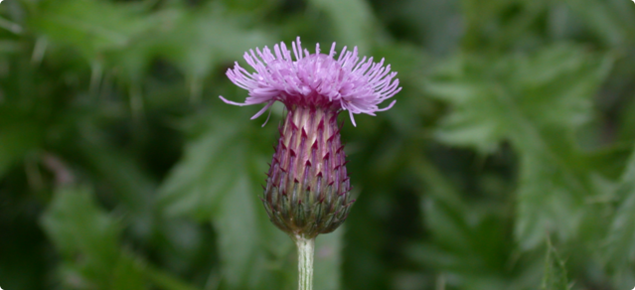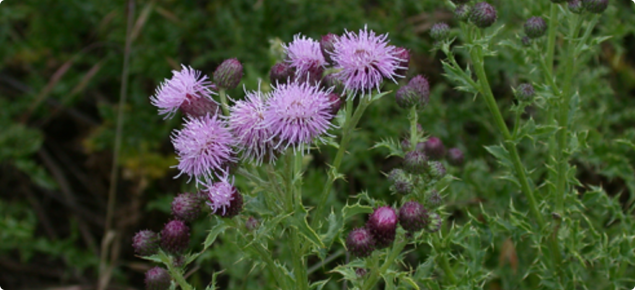Form: herbaceous — perennial
Status: eradicated from WA
Perennial thistle is a native of Europe, Asia and North Africa, but has been established as a major weed in North America since the eighteenth century. It is also established in New Zealand, Tasmania and Victoria. Outbreaks have been recorded at Geraldton in 1933 and later at Fremantle and Walpole. No plants have been found in WA for many years.
Weed of pastures, crops, roadsides and wasteland in higher rainfall areas, particularly in Victoria and Tasmania.
Appearance
A creeping, rooted perennial producing erect shoots to 1.2 metres, commonly to 60–90 centimetres. It grows in cooler months, dying back in autumn to re-shoot from root buds. Forms large colonies with dense growth crowding out desirable plants.
Stems: slightly winged below the leaves, slightly hairy and branching at the top.
Leaves: stalkless dark green leaves with irregular spiny lobes; rosette leaves 15 centimetres long, stem leaves 20 centimetres long and more deeply lobed, alternate, and leaf bases continuing down the stem for a short distance.
Flowers: the flower heads are spineless and small compared to other thistles; flowers are variable in colour usually rose-purple but occasionally pink to white. Each flower head is 2–2.5 centimetres long 1.5–2.5 centimetres in diameter. Each plant bears numerous flower heads in clusters. Male and female flowers are produced on separate plants.
Seeds: light brown to olive green, smooth, shiny and finely grooved slightly flattened and curved 2.5–4 millimetres long, one millimetre wide and pappus two to three centimetres long.
Online weed identification training
Login or set up a new account on DPIRDs online training site to access:
- a training course on how to identify perennial thistle and report it.
- training material that you can use to teach community groups how to identify perennial thistle.
Agricultural and economic impact
Perennial thistle is a highly invasive weed that competes vigorously with broadacre and horticultura crops and pastures for nutrients. It may also interfere with crop harvesting. Some of the herbicides used to control perennial thistle are detrimental to crops and pastures.
Sheep forced to graze Perennial thistle may develop mouth infections from the sharp spines. Perennial thistle can develop herbicide resistance.
Declared pest category
The Western Australian Organism List (WAOL) contains information on the area(s) in which this pest is declared and the control and keeping categories to which it has been assigned in Western Australia. Search for perennial thistle in the WAOL using the scientific name Cirsium arvense.
Requirements for land owners/occupiers and other persons
Requirements for land owners/occupiers and other persons if this pest is found can be sourced through the declared plant requirements link.
Search > detect > report
| MyPestGuide™ Reporter | Pest and Disease Information Service (PaDIS) |
Detectability: very hard to find: can be confused with other thistles and is not expected to be present in the state. Perennial thistle leaves are spiny, but the flower heads are spineless and smaller than other thistles.
Who is likely to find it: potentially anyone in high rainfall areas of the South West Land Division.
When to find it: perennial thistle is most conspicuous when flowering, from late spring to early summer.
Where to find it: perennial thistle has been found three times in WA: in Geraldton in the 1933, in Walpole in 1948-52 and Fremantle in 1986. Geraldton and Fremantle both have ports and railway line, Nornalup (just east of Walpole) had a railway in 1929 that was connected to the port in Albany. If perennial thistle is found again in WA, it is most likely to be in the higher rainfall parts of the South West Land Division. In other states it is found in crops and pastures and on roadsides and waste land.
Control method
Control methods for this declared plant can be found through the perennial thistle control link.
Management calendar
(a faded icon means Occasionally)



